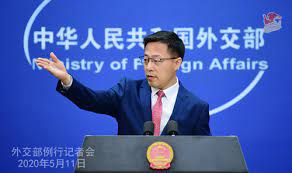Published: August 30,2022
By Gerald Mbanda

After the controversial visit by US House Speaker Nancy Pelosi on August 2, the US has continued to provoke China by announcing arms shipment to Taiwan as well as sending warships in the Taiwan Straits which is an out right violation of “one China Policy.” After the U.S. cruisers Chancellorsville and Antietam sailed through the Taiwan Straits on Sunday, Washington denied violation but instead argues that, “the passage of the U.S. warships was “very consistent” with the U.S. “one-China policy” and seeking “a free and open Indo-Pacific.”
The Chinese Ministry of foreign affairs spokesperson, Zhao Lijian, refuted Washington claims of abiding by the “One –China policy and warned the United States against being the “troublemaker for peace and stability of the Taiwan Straits.” Zhao made the remarks during a regular press briefing on Monday in Beijing.
U.S. warships frequently flex their muscles under the pretext of “freedom of navigation,” which is not a commitment to freedom and openness, but a provocation to seek “freedom of willful trespassing,” Zhao told journalists.
“China urged the U.S. side to stop hollowing out the one-China principle, abide by the one-China principle and the provisions of the three China-U.S. joint communiques honestly, and not to be the troublemaker for peace and stability of the Taiwan Straits,” he said.
In its sinister motives to destabilize and disrupt the rise of China, Washington is reading from the same script from which it is working with NATO to destabilize Russia by arming and sparking the war with Ukraine. United States believes in aggression and use of forcethough proxy wars to maintain its hegemony. The un-spoken absurd principle of the US which is against peaceful coexistence and shared development, is that it does not tolerate any country to surpass it in terms of economic development and military capability. The Crime of China is that it is threatening both.
China’s GDP is projected to grow 5.7% per year through 2025 and then 4.7% annually until 2030, British consultancy Centre for Economics and Business Research (CEBR) forecasts. Its forecast further say that China, now the world’s second-largest economy, would overtake the No. 1-ranked U.S. economy by 2030. Credit insurance firm Euler Hermes made a similar forecast.
China is now fully committed to developing “intelligentised” warfare, or future military methods based on disruptive technologies – especially artificial intelligence, according to the US Department of Defense. China’s Academy of Military Science has been given a mandate to make sure that this happens, through “civil-military fusion”, in other words joining up Chinese private sector technology companies with the country’s defence industries.
Many Western observers now believe a profound shift in the global balance of military power is under way. President Xi Jinping has ordered China’s armed forces to modernise by 2035. They should, he says, become a “world-class” military power, capable of “fighting and winning wars” by 2049. The Chinese government set two centenary goals or Liang ge yibai nian, to be achieved by 2021 and 2049, marking centenaries of the Chinese Communist Party and the Republic of China respectively.
In 2021, China realized the first centenary goal of “building a moderately prosperous society in all respects.” Absolute poverty was completely eradicated. By 2049, China aims “to build a modern socialist country that is prosperous, strong, democratic, culturally advanced and harmonious.” The big question here remains; will Washington manage to stop China’s development trajectory?
Gerald Mbanda is a Researcher and publisher on China and Africa.
For comments or opinion write to us on info@africachinareview.com
 Africa -China Review Africa -China Cooperation and Transformation
Africa -China Review Africa -China Cooperation and Transformation
